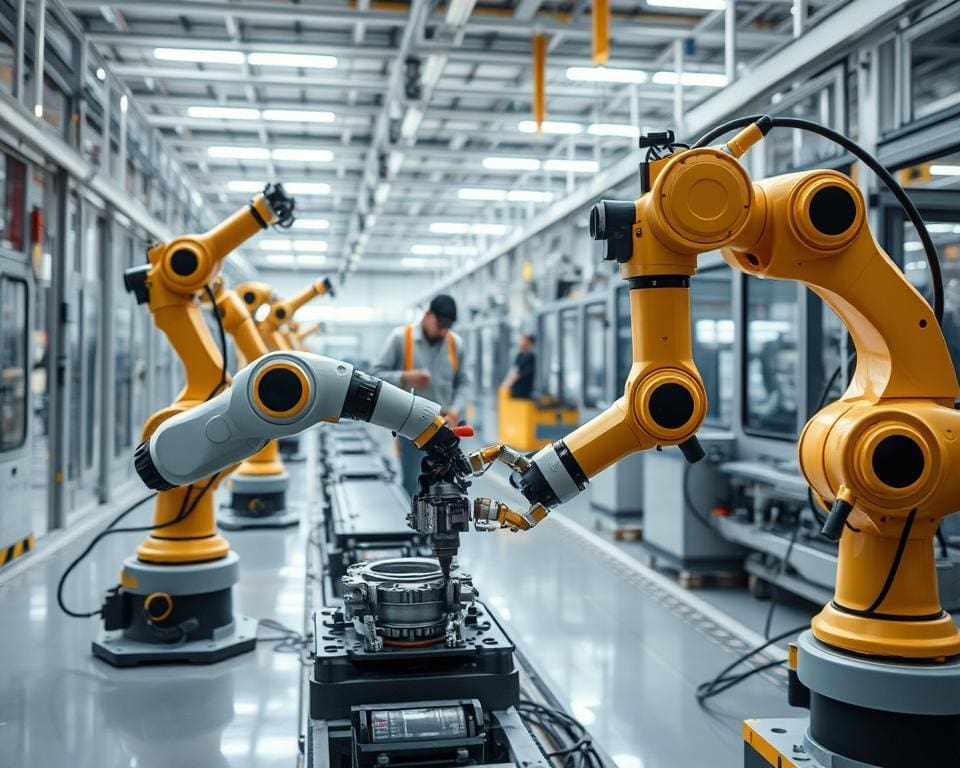In today’s rapidly evolving industrial landscape, the integration of robotics is transforming workplace safety. These advanced safety technologies play a pivotal role in enhancing employee protection by minimising risks and promoting a safer working environment. Through automation, robotics not only streamline operations but also significantly reduce the potential for human error, safeguarding workers in various settings. As we explore the multifaceted benefits of robotics in ensuring workplace safety, we uncover how these innovations are not merely tools, but vital partners in creating a culture of safety.
The Rise of Robotics in the Workplace
The integration of robotics into various industries marks a significant shift towards enhanced efficiency and improved safety standards. The rise of robotics ushers in new advancements in automation, affecting sectors from manufacturing to healthcare. This evolution reshapes how tasks are performed and prioritises the well-being of employees across the board.
Understanding Automation in Various Industries
Automation plays a pivotal role in transforming workplaces, leading to notable advancements in production capabilities. Industries such as automotive, electronics, and pharmaceuticals leverage robotic systems to streamline operations. As a result, benefits include:
- Increased efficiency in production
- Reduction of human error
- Enhanced precision in tasks
The application of robotics promotes higher safety enhancements, ensuring that hazardous tasks are managed effectively, thereby protecting workers and minimising risks.
Historical Context of Robotics in Safety Improvements
The historical context of robotics reveals a compelling journey towards enhancing workplace safety. Pioneering innovations, such as Ford’s assembly line techniques, represented early efforts in automating repetitive tasks. Over the decades, the transition towards robotics in environments deemed hazardous underscored the necessity for improved safety protocols. Each breakthrough paved the way for current practices that emphasise not just productivity but also the well-being of the workforce.
How does robotics improve workplace safety?
Robotics plays a pivotal role in enhancing workplace safety by addressing critical areas such as reducing human error and optimising emergency response protocols. As industries continue to integrate advanced technologies, the impact of these innovations on safety improvements becomes increasingly evident. The robotics benefits extend far beyond simple automation, offering substantial enhancements in operational efficiency and safety.
Reducing Human Error
One of the foremost advantages of robotics in the workplace is the significant reduction in human error. Tasks that are prone to mistakes, such as repetitive or high-stress activities, can be delegated to robots. This shift not only alleviates the burden on human workers but also leads to more consistent outcomes. By minimising the chance of errors, companies experience fewer accidents, creating a safer working environment.
Enhancing Emergency Response
Robots are designed to follow programmed protocols, making them invaluable during emergency situations. Their ability to assess crises and execute predetermined responses ensures that reactions are swift and effective. This capability can be instrumental in saving lives and minimising injury, reinforcing the concept that incorporating robotics into safety plans greatly enhances emergency response strategies.
Types of Robots Enhancing Safety
The landscape of workplace safety is rapidly transforming through the integration of various types of robots. Two significant categories leading this revolution are collaborative robots, commonly known as cobots, and autonomous mobile robots, referred to as AMRs. Each type plays a unique role in boosting safety measures in modern industrial settings.
Collaborative Robots (Cobots) and Their Role
Collaborative robots, or cobots, are designed to work alongside humans in a shared workspace. These robots enhance safety by taking on repetitive or hazardous tasks, allowing human workers to focus on more complex and critical functions. The presence of cobots reduces the likelihood of workplace injuries by minimising human exposure to dangerous environments and heavy machinery. Their intuitive design enables seamless interaction with human operators, fostering a culture of teamwork and enhancing overall productivity.
Autonomous Mobile Robots (AMRs) and Navigation Safety
Autonomous mobile robots are integral to enhancing navigation safety in environments such as warehouses and manufacturing plants. These robots possess advanced sensors and algorithms, enabling them to navigate complex layouts efficiently. By automating material transport and handling, AMRs significantly reduce the risk of accidents caused by human error. This not only ensures a safer environment but also streamlines operations, allowing businesses to maintain high safety standards while boosting performance.
Real-World Applications of Robotics
Robotics has seen remarkable advancements, translating theoretical ideas into real-world applications that enhance efficiency and safety across various sectors. Concrete examples showcase how robots transform manufacturing processes, operate in hazardous environments, and lead innovations in healthcare, demonstrating their indispensable role in modern industry.
Case Studies in Manufacturing
Manufacturing case studies reveal the profound impact of robotics on productivity and safety. For instance, companies like BMW utilise robotic systems for precision assembly and quality control. These systems reduce human error, contributing to improved safety standards while allowing human workers to focus on more complex tasks. In Siemens factories, robots work alongside humans, performing repetitive tasks that lower the risk of injuries and enhance overall workplace safety.
Robots in Hazardous Environments
In hazardous environments, robotics provides solutions that significantly mitigate risks. Bomb disposal units employ robots such as the Talon, allowing experts to safely handle and disarm explosives from a distance. Likewise, in the field of toxic waste management, robots like the ROV (Remotely Operated Vehicle) work in contaminated areas where human exposure poses serious health threats. These real-world applications highlight the critical role robotics plays in ensuring safety during dangerous operations.
Healthcare Sector Innovations
Healthcare innovations are reshaping patient care through robotic assistance. Surgical robots, such as the Da Vinci system, enable surgeons to perform minimally invasive procedures with unparalleled precision, significantly reducing recovery times and risks of complications. Moreover, robots in healthcare settings assist with patient monitoring and rehabilitation, ensuring a safer environment for both patients and medical professionals. These advancements underscore the transformative power of robotics in improving healthcare delivery.
The Impact of Robotics on Risk Assessment
Robotics significantly enhances risk assessment through innovative techniques in data collection and safety analysis. With the implementation of IoT-enabled devices, organisations can gather real-time information about workplace conditions. This continuous monitoring plays a crucial role in identifying potential hazards before they escalate, thereby promoting a safer environment for employees.
Data Collection and Safety Analysis
Effective risk assessment relies heavily on comprehensive data collection. Robotics facilitates the gathering of intricate data sets, which are essential for thorough safety analysis. Sensors and automated systems collect information on machinery performance, environmental factors, and human interactions. Processing this data leads to informed decision-making and the identification of unforeseen risks.
Predictive Maintenance and Its Benefits
Predictive maintenance represents another key advantage of robotics in the workplace. By leveraging advanced analytics, robotics can anticipate equipment failures, enabling businesses to undertake maintenance before incidents occur. This proactive approach not only minimises downtime but also significantly limits risks associated with equipment failure, safeguarding both personnel and assets.
Challenges in Implementing Robotics for Safety
The integration of robotics into workplace safety protocols is an exhilarating prospect, yet it does not come without its hurdles. Businesses encounter various implementation challenges that must be navigated to harness the potential of robotic technology effectively. Addressing these challenges often involves a careful examination of cost considerations against the long-term benefits that robotics can bring.
Cost Considerations vs. Long-Term Benefits
Initial investment is a primary factor influencing the decision to adopt robotics for safety improvements. The upfront costs for robotic systems can be significant, leading companies to weigh these expenses against the projected long-term benefits. These benefits frequently include a decrease in workplace accidents, which can translate to lower insurance premiums and reduced liability. The potential for improved productivity and efficiency also plays a vital role in justifying the initial outlay.
Workforce Adaptation and Training Needs
Implementing robotics requires more than just financial investment; it necessitates a cultural shift within the workplace. Workforce training is crucial for ensuring employees adapt seamlessly to the new technology. Providing comprehensive training sessions enables workers to understand how to operate alongside robots effectively. This adaptation process not only boosts confidence among employees but also enhances overall safety as they learn to interact with robotic systems safely and efficiently.
The Future of Robotics and Workplace Safety
The future of robotics promises to significantly elevate workplace safety through innovative technological advancements. As industries evolve, the integration of artificial intelligence and machine learning into robotic systems is set to create smarter, more adaptable machines capable of addressing complex safety challenges. This shift indicates a strong trend towards automated solutions that not only enhance efficiency but also rigorously uphold safety standards.
Safety improvement trends suggest that as robots become increasingly sophisticated, they will be able to perform precise risk assessments and respond to emergencies with unparalleled agility. This responsiveness can transform workplace environments, allowing human workers to focus on higher-level tasks while robots manage hazardous situations, ultimately safeguarding personnel and reducing accident rates.
Investing in the future of robotics in workplace safety is not merely an option; it is becoming an imperative for organisations committed to their employees’ well-being. As these technologies continue to advance, the fusion of human intuition and robotic efficiency may pave the way for a safer and more productive working landscape, ensuring that safety is entrenched in every facet of operation.









